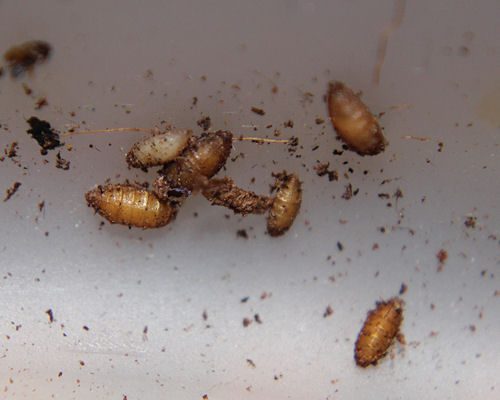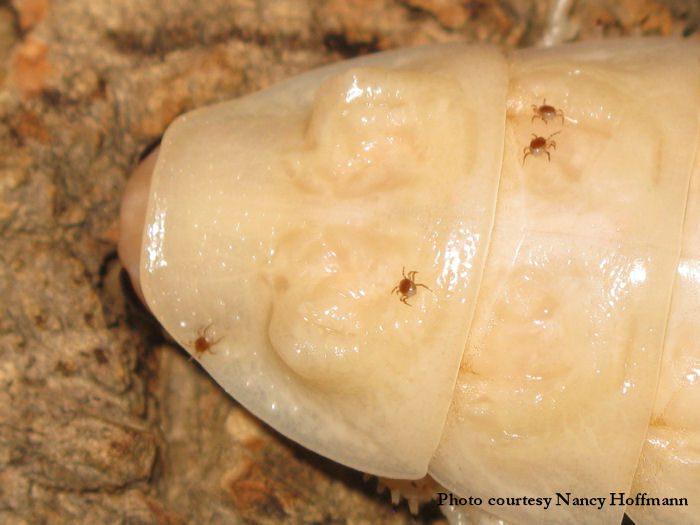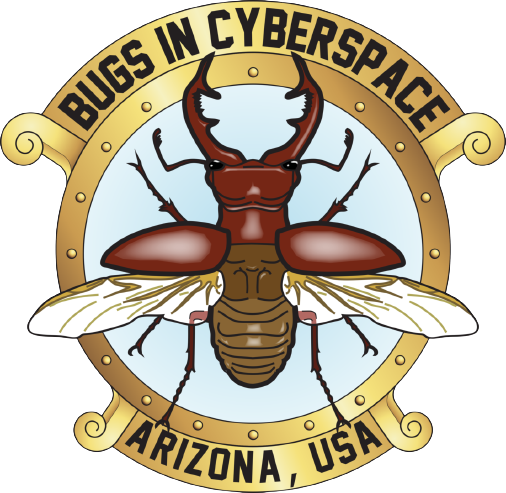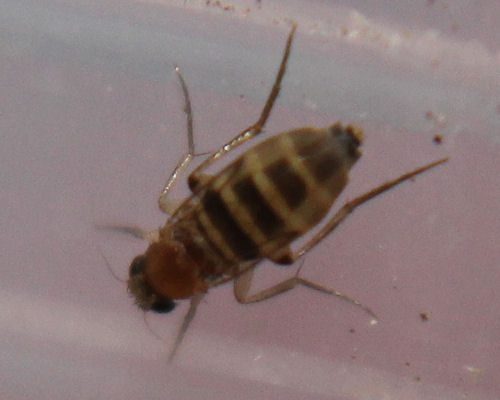Cage Pests
A variety of flies, beetles, ants, mites, mold, and other fungus and bacteria take advantage of the ideal conditions that we set up for our pet insects, tarantulas, reptiles, amphibians and plants. The combinations of soil or dirt, sand, coconut fiber, peat moss and other substrates we use to line the bottom of our tanks provides breeding grounds for many different kinds of pests. The humidity that we maintain in the cage also invites these unwanted visitors. The decomposition of any organic matter in the cage, from the substrate itself, to leftover bits of food and feeder insects, to bits of plant material will draw in opportunistic pests. Though pest outbreaks are relatively rare if the keeper makes even a minimal effort to clean up their pet's cage every once in a while, it's good to be aware of prevention and solutions to pest problems. It's really not that common and it's really not that hard to deal with.
Before I go on, it is important, at least to me, to point out that it is no more natural to keep a pet in a cage than it is to designate uninvited guests as pests of that cage. Therein lies a moral distinction comparable to how we, as humans, treat the natural world around us. Miles and miles of cornfields feed people (and cows). Insects that feed on this corn are described as pests. (Indeed, it is important for us to eat corn, and to a lesser extent, cows.)
The land we use for this purpose, of course, resembles nothing of its natural state. Both native and non-native insects with a taste for corn will take advantage of this imbalance and set up residence in proportion to the availability of food. Farmers (AKA "industry") use a variety of unnatural methods to combat the invaders, including pesticides. And so it goes, with layer after unnatural layer building upon our decision to landscape the land.
What point in the practice do we find the pest? Is it the insect that feeds on the corn? Is it the corn that is grown, displacing all other plant life? Is it the person that plants the corn? Is it the company that makes money off the corn? Is it the person that eats the corn? Is it the cattle industry that grows corn to feed the cattle to in turn feed the American demand for beef? So it goes, and so we find that the word pest is just a descriptor we use to label an organism that is taking advantage of an imbalance we created in the environment.
So it is in our tanks. As there are many organisms that have no interest in corn, there are many who have no interest in the habitats we create in glass aquarium tanks, plastic terrarium, net cage, or any of the other types of pet housing enclosures. Yet, nature's abundance will surely always provide a handful of species that thrive in the exact same captive conditions as our pets. These include a wide variety of species from varying groups.
The purpose of this page is to expand our understanding of the causes and effects of pests in our tank (defined best, maybe, as unwanted inhabitants), and to discuss best practices for their prevention and removal. These topics are regular features on hobby forums, but no single internet source seems to deal with the issues to my satisfaction. So, off we go...but not before my invitation to readers to suggest corrections and additions to this page. If you would like to donate spectacular photos or videos (of your own creation) to this page, please contact me.
Fungus Gnats
These are commonly confused with fruit flies when they are encountered in the home for the simple reason that most human beings are only familiar with flyings insect this size in association with warm weather and their fruit bowl. Just how big does an animal (yes, insects are animals) have to be to earn its own name? Or just how annoying does it have to be to show up on the map of human attention? Malaria, for example, is not caused by the mosquito itself, but by an organism that lives in the gut of mosquitoes on its way from and to vertebrate hosts. We might notice the mosquito, but we probably wouldn't care about the tiny Plasmodium parasites if they didn't cause malaria. Back to the point, fungus gnats, though completely harmless to people and our pets are common enough in most households to deserve recognition as being something distinct from fruit flies. They are present most familiarly in our houseplants, where again they go mostly unnoticed. They are easily differentiated from fruit flies or phorid flies by their elongate bodies which are rather thin and taper to a fairly obvious point at the end of the abdomen. Though they are rather slow fliers, their wings are large in comparison to the body. Wings are always translucent, though some species exhibit smoky, grayish wings. Wings are nearly the length of the abdomen or even slightly longer.
Fungus gnats (larvae) feed on decomposing bits of organic matter, including especially fungus. You may not be able to see the fungus they feed on, or even hardly these tiny flies themselves. Fungus and mold grow in moist places and can be so small that we can't see it. The flies consist of several genera and are sometimes referred to as dark-winged fungus gnats, perhaps most familiarly in the genus Sciaridae. They are important vectors of pollen for some plants and spores for fungi.
Our pet tanks provide suitable habitats for them when they are moist and contain bits of decomposing organic matter that begins to mold. Like most other flies in the order Diptera their life cycle consists of egg, larva, pupa, and adult fly.
The video I took below documents the larvae, and breeding habits of the adults. Larvae are transparent with a black-tipped head. Adults can be distinguished from the other flies on this page in several ways. They are generally a bit smaller and have abdomens that taper to a rather sharper point. They seem to choose equally between running and flight when evading the squishing finger of death. They are fairly weak fliers but are more inclined to do so than the next fly species in our list of cage pests.
Phorid Flies
These may superficially resemble fruit flies with their yellow to orange bodies, but they generally have a more striped or banded appearance. They also tend to look quite plump. The easiest factor in identifying the adults is the curious way in which they move. They remind me of tiger beetles which are said to move so quickly, but in short bursts, that they have to stop just to get their bearings and see where they are going next.
Phorid flies definitely prefer to run, rather than fly. Wings are rather short and may not extend past the abdomen. Their running behavior can be described as jerky, quirky or sporadic, and fast. Imagine somebody running down a hallway in the dark, past one of those strobe lights that were so popular in the 1980s. What ever happened to mine? Hmmm...
Pupae are the little cocoon-like structures where metamorphosis, from larva (maggot) to adult, takes place. When a full-grown larva is ready to pupate it will often climb the side of the tank and look for a safe place away from the substrate to do so. However, they will often do it beneath the substrate as well. In the photo below you can see a white larva (upper left) that has just glued the tip of its body to the tank wall and is preparing to pupate like the other surrounding pupae.

Larvae of phorid flies (family Phoridae) are white and much more maggoty looking than those of fungus gnats. The word maggot pretty much sums up their plumper appearance and their excited, wriggling movements as they voraciously make their way through their meal.
Food, in the case of our pet tanks, is usually the freshly dead, decomposing body of a pet or feeder insect. An adult fly can smell death from your backyard and make their way in through the ventilation holes in your cage's lid. In the one sense, they are just cleaning up after the mess you made, but I personally find that there is little to be appreciated by the experience of finding one of your favorite pet bugs dead and being consumed by dozens of writhing maggots. I'm working on that though. Part of the reaction is the knowledge that four phorid flies usually fly out of the cage when you popped the lid off and are on their way to the next unsuspected cadaver six tanks away.
Here is a video of a Blaptica dubia cockroach that had probably died 5 to 7 days before I discovered it dead in its tank. Note that, aside from a very small handful of reports, phorid flies do not attack living animals.
Mites
There are a variety of mites that appear in our pets' tanks. Mites are very small arachnids in the order Acari, which includes ticks. People often express confusion about where the mites came from, and the answer is surprising. Mites are everywhere.
In fact, they're crawling all over your body (see Demodex folliculorum). Another familiar mite is the house dust mite (see Dermatophagoides). So mites are just cruising all over our homes all the time, looking for a meal and laying hundreds of eggs. The ones we see in our pet tanks usually appear in association with uneaten leftovers in our pet's food dish. Cereal (grain) products and protein-based products seem to be the most attractive to mites. Spider mites (see Tetranychidae) are common pests of plants, but don't usually proliferate in our tanks.
The most common mites we see in our tanks are grain mites (see Penn State article). These appear as rather slow-moving pale, sometimes brownish mites. Young mites are very small but resemble the adults, at least to the naked eye.
A few species of pet insects have their own species of commensal mites. These mites live on another organism, but do not harm it or provide any significant benefit to the organism (like cleaning, for example). A familiar example of a hobby species exhibiting commensal mites is the African Giant Black (AGB) millipede (see video below beginning at about the one minute mark).
Photo of Commensal Mites on Hissing Cockroaches

Mites have been reported to feed on the eggs of Dynastes rhino beetles, but my observations are that they do not in fact kill the eggs. I suspect that mites live on adults in the wild and merely live in proximity to the eggs and larvae, later using the adults for transport to greener pastures (a mode of distribution known as phoresy).
Fruit Flies
These are the small flies that are probably so common a description is not necessary. They often have red eyes and orange bodies with slightly dark markings in places. They are attracted to fermenting fruits in our pets' cages. Their larvae will be confined to the fruit itself and they won't be attracted to non-fruit foods or decomposing remains of insects. Simply removing the rotting fruit from the cage will eliminate their presence, however, they may return quickly to the cage if you add fresh fruit again because they usually disburse as you're opening and closing the cage.
These are most likely to occur during the warmer months of the year as wild flies that come in through open doors or windows. When my wife "gently" encourages me to fix the problem, I will set up traps. I simply put a slice of apple into a deli cup and leave the lid ajar just enough to allow the fruit flies to enter. After several hours I push the lid closed and carry the container of flies back outside where they came from, releasing them.
Of course, if you suspect your fruit flies are not native to your yard (because you bought them, for example), it is best not to release them outdoors. In this case, either feed them to your pets or pop them in the freezer for 20 minutes. You can reuse the container over and over again and it will actually become a more effective trap as the fruit begins to rot. Red wine can also be added to the bottom of the container to attract the flies.
Nematodes
These translucent worms are actually one of the most frightening pests to find in your pet cage. They are one of the animals that can, under some circumstances, directly compromise the health of many animals. They are ravenous feeders on the eggs of pet beetles. A parasitized tarantula may exhibit them around its mouth causing it much irritation to a point that it ceases to feed.
Still, nematodes occur everywhere and are one of the most numerous organisms on the planet. The tons of them in a single spoonful of backyard soil is not inaccurate. Their presence in our pets' tanks seems mostly restricted to tarantulas and within that group, usually wild caught (infected) tarantulas. The phenomenon probably seems more common than it actually is when the huge number of tarantula hobbyists is compared to the very few incidences of occurrence. You can diminish the likelihood of nematode problems by using only sterilized substrates in your pets' cages. Nematodes cannot tolerate dry conditions, so they are more likely to occur in humid tanks.
Elaterid Larvae
Elaterids are these funny little beetles that have a unique ability which helps us to identify them. The adult beetle's body has three segments like other beetles, but it really only appears that they have two since the head is comparatively small and mostly overshadowed and seems absorbed by the larger thorax. This insect has a special apparatus. When the insect finds itself upside down its legs are too short to allow it to right itself and this is where this beetle earns its common name. Upside-down "click beetles" are able to right themselves by using this apparatus in such a way that they spring into the air and land on their feet. Each time they execute an attempt, a surprisingly loud click can be heard.
Now, the larvae of this beetle are commonly referred to as wireworms. They look superficially like elongate mealworms and some of them are predatory. They sometimes make their way into our tanks via wood or dirt that we gather from the outdoors. They are most familiar to keepers of pet beetles where they sometimes cause damage or death to pupae or eggs.
Fungus Mold
Fungus and mold are ever present in our pets' cages. However, it may go mostly unnoticed in much the same way that all the surfaces in our homes are caked with countless, microscopic spores. The most obvious instance of fungus in our tanks occurs on the decomposing remains of the food we offer.
Fruit, grain products, and protein-based dry pet foods are all very susceptible bases for the growth of mold. Humidity exacerbates the appearance and progression of mold. Consequently, decreasing humidity will slow the growth of mold. When conditions are right, a single spot of some species of mold is capable of taking over the entire tank.
More commonly, the mold will be confined to the leftover bit of food and perhaps a small periphery of substrate. Watching out for mold and spot cleaning it at the first signs is essential. Mold problems to the point where a complete substrate change is required are very rare, though some substrates will need to go through an acclimation period. There is an unseen balance of competing and cooperating microorganisms all around us and in our tanks.
An acclimation period is sometimes required for a newly created substrate or substrates that have been sterilized because the balance of microorganisms, good and bad, has been eliminated. Little spots of mold may temporarily take advantage of an otherwise barren, organic substrate but a few weeks of spot cleaning and patience should achieve a state of harmony again.
Two kinds of mold seem especially destructive. One is a white to gray mold that may look like the crowns of cauliflower, but fuzzy. Growth is carpet-like. The other is a very rapid growth variety that sends out inch long hairlike, fungal hyphae. These may seem to appear overnight and spread quickly in the search for additional, suitable bases. The hairlike filaments may be grayish and end in tiny black dots.
Protein based food sources seem the most common causes of this kind of fungal growth, in my experience. Colorful types of fungus or mold seem less worrisome. Greens, oranges, and black forms seem to restrict themselves to very small spots and are less concerning. Of course, it is still recommended that you remove these for sanitation and aesthetic reasons.
We're not growing mold, we're growing bugs! For the most part, mold and fungus are really not sources of regular or significant concern in pet bug tanks. In fact, many bugs may nibble on the mold. The root-like mycelia of mushrooms or fungus are often intentionally cultured in kinshi bottles to feed stag beetles, and springtails feed well on different types of mold.
An article in the journal American Arachnology discusses spiderlings being infected by a fungus they contracted through feeding on fruit flies. Yes, the article reads like the title itself: A ZYGOMYCETOUS FUNGUS AS A MORTALITY FACTOR IN A LABORATORY STOCK OF SPIDER
Bacteria and Viruses
There is very little confirmed information about the benefits and detriments of various types of bacteria living in our pet tanks. Certainly, bacteria are ubiquitous and many species depend on it to help them digest their food, much like humans depend on E. coli.
Our bodies are like ecosystems where all the competing and cooperating organisms live together in a state of apparent balance. Still, it is truly surreal to consider that we are "only 10% human. 90% of cells in your body are bacterial" as explained in this entertaining YouTube video from the show "Curiosity: World's Dirtiest Man" with Mike Rowe. Watch it! It's funny and gross, and you'll learn more than you ever wanted to know. Knowledge is a good thing, right?
So, one bacterium that occasionally gets press in the pet bug hobby is Wolbachia. These specifically live in association with arthropods. Very little information has crossed from science into the hobby on other species of bacteria and the extent to which they affect our pets. It is presumed that many of the "mystery deaths" that occur in otherwise young or healthy individuals are due to bacterial infections. This may be the case when an otherwise healthy specimen is shipped from the colony of one keeper to a new keeper. While the source colony may remain healthy, the new individual or individuals may founder in the new habitat as a result of the change in the balance of the local ecosystem.
One example of a hobby theory on bacteria as the cause of sickness and death is "the black goo of death.” An otherwise healthy mantis will suddenly begin to excrete a black liquid which will appear on tank walls or paper towels, etc. Within a week or two, the mantis will die. The vector, in this case, is usually attributed to crickets purchased from pet stores. That's not to say the majority of pet mantises aren't fed crickets without consequences, but there does seem to be a pattern of occurrence.
Another theory that sometimes perpetuates itself in the hobby is that a bacterium living on pet roaches may be the cause of what is called "black spot disease" in the larvae of pet beetles.



